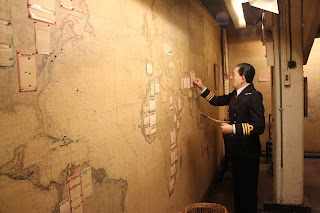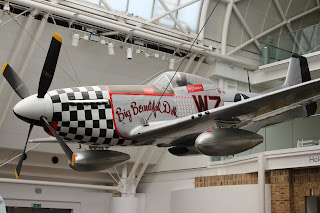Well I guess we have reached that point...coming up on a the end of our time in London, and watching our time here dwindle away. Seems we have gotten just about all we can get out of the city, as I seem to be continuously underwhelmed by the things we go see and do. Don't get me wrong there are some great sights and fascinating places, but they all seem to be done and gone now. With the seemingly never-ending supply of shows and events which are sold out, we have been left with a seemingly never-ending supply of attractions which are maybe marginal at best. You know the kind of place I am talking about. The museum which if you specially interested would be great but otherwise you have to fain a level of interest just to keep your feet shuffleing through the exhibit. Kinda like visiting the Jenks aquarium for the second time....just hard to justify the $20 to look at a fishbowl. With all that said we visited both the London War museum and the Churchill Warrooms recently.
Churchhill Warrooms was easily the most interesting. Probably more so because it was something that we knew about to begin with. There are so many British wars and conflicts that as Americans were don't learn about that the museum was a bit dull at times. Construction of the Cabinet War Rooms, located beneath the Treasury building in the Whitehall area of Westminster, began in 1938. They became operational in August 1939, shortly before the outbreak of war in Europe. They remained in operation throughout the Second World War, before being abandoned in August 1945 after the surrender of Japan. During its operational life two of the Cabinet War Rooms were of particular importance. Once operational, the facility's Map Room was in constant use and manned around the clock by officers of the Royal Navy, British Army and Royal Air Force. These officers were responsible for producing a daily intelligence summary for the King, Prime Minister and the military Chiefs of Staff. The other key room was the Cabinet Room. Prime Minister, Churchill visited the Cabinet Room in May 1940 and declared: 'This is the room from which I will direct the war'. In total 115 Cabinet meetings were held at the Cabinet War Rooms, the last on 28 March 1945, when the German V-weapon bombing campaign came to an end.
On 22 October 1940, during the Blitz bombing campaign against Britain, it was decided to increase the protection of the Cabinet War Rooms by the installation of a massive layer of concrete known as 'the Slab'. Up to 5 feet (1.5 metres) thick. The Slab was progressively extended and by spring 1941 the increased protection had enabled the Cabinet War Rooms to expand to three times their original size. While the usage of many of the War Rooms' individual rooms changed over the course of the war, the facility included dormitories for staff, private bedrooms for military officers and senior ministers, and rooms for typists or telephone switchboard operators.
Two other notable rooms include the Transatlantic Telephone Room and Churchill's office-bedroom. From 1943 the former housed a SIGSALY encrypted telephone enabling Churchill to speak securely with American President Roosevelt in Washington.
Churchill's office-bedroom included BBC broadcasting equipment; Churchill made four wartime broadcasts from the Cabinet War Rooms.
Churchill's office-bedroom included BBC broadcasting equipment; Churchill made four wartime broadcasts from the Cabinet War Rooms.
 |
| Churchhill's Bedroom |
 |
| And his cabinet in the hall |
Here are some pics of the War Museum and the rest of the Warrooms



















No comments:
Post a Comment